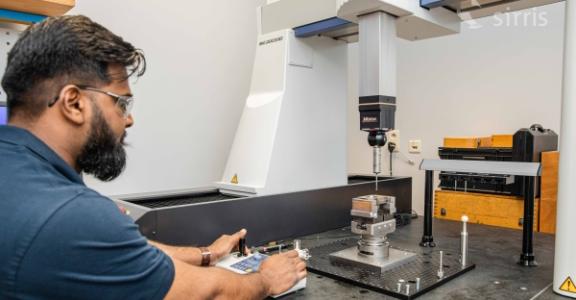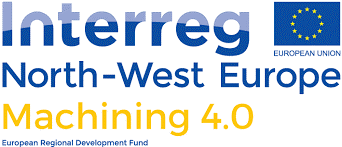Innovative technologies making companies stronger and more competitive for the future also have a lot to offer to the machining industry. The Interreg project 'Machining 4.0' translates the broad Industry 4.0 vision into concrete applications for machining, tailored to SMEs. Within this context we established ten practical guidelines.
To better prepare them for new challenges such as small series, more complex products and shorter lead times, the Interreg project 'Machining 4.0' aims to support machining SMEs in integrating innovative technologies into their production: collaborative robots, digital production, innovative processes, ... The focus of the project is on the development of practical tools, applications and workshops so that these SMEs can start working with recent developments within Industry 4.0.
The following practical guidelines were established after consultation with the Machining 4.0 consortium based on many years of experience with helping companies.
1. Do the basics first
It doesn’t make sense to adopt novel technologies, as long as the basic processes are not under control. For example, it’s counterproductive to install automated guided vehicles if the corridors can’t be kept clean, which is needed to allow the vehicles to pass.
2. Don’t jump to solutions
First, understand the deeper problem and the capabilities of the organisation needed to absorb novel technologies. This should be done by first assessing the process and the maturity of the organisation before exploring the solutions. An organisation needs to make sure that its support staff has the necessary skills to adopt and maintain novel technologies. The necessary prerequisite systems (e.g. wifi on the shop floor) should also be in place before some solutions can be implemented.
3. Clarify the business case
Before you decide on a major investment, make sure that you detail the business case upfront. Make an estimate of the value of the expected benefits and detail all the expected costs. Look at all the costs, not just at the cost of the equipment itself. The following costs are important, but are often neglected: maintenance costs, training costs, costs for additional highly skilled personnel (programmers), cumulated software fees, costs associated with potential breakdowns of the additional technologies (sometimes with a companywide impact) and costs related to cybersecurity like insurance costs.
4. Don’t underestimate the needed skill levels to operate novel technologies
Programming novel technologies - such as digital work instruction systems with projection - will take some time before your personnel masters the technology. Besides the initial learning, the maintenance of the skill set is also important. If people only need to program a system infrequently, they will need to relearn how to operate the system.
5. Don’t just select the right solution, also select the right implementation partner
Engaging with external partners enables you to learn from experience gathered at other companies. Once you decided to work with an external partner, selecting the right partner becomes a key success factor. Your partners need to have the right analytical and technical skills during the implementation phase, and must be able to adequately respond during the maintenance phase. A good project starts with clear expectations: identify the needs and write down the specifications to prevent later misunderstandings.
6. Turn your data into value
Industry 4.0 applications will typically collect a lot of data. However, data itself has no value, so collecting and storing data is just a cost. Making fancy management visuals may impress people, but has no real value. The value of data only emerges when you actually do something with the data that leads to measurable improvements. Setting specific improvement targets can help to focus your people, to turn your data into value.
7. Ensure the involvement of the operators
With all the data that becomes available, it becomes more important than ever to translate the insights into actions! Reaping the benefits of all the data associated with Industry 4.0 often requires a cultural shift. Management must understand that the task of the operator is not just to produce, but also to improve the process. The goal of all the data collection is to enable the operator to do a better job, not to better control the operators. Trying to better control the operators will only lead to resentment and distrust. Raw data can be complex to interpret for the operators. Therefore, good data visualisation is essential to keep the operators involved. One more thing: make sure that your software is user-friendly, for example, your operators should be able to find all their information in 3 to 5 clicks.
8. Look at the big picture, but start small
Improvement opportunities cannot only be found on the shop floor, but also in the office operations, especially in order processing, engineering, work preparation.
Don’t just look at the situation right now, but make sure that your technology is futureproof (think about standards like OPC-UA, MTConnect, …). Furthermore, also think about the energy and environmental concerns.
Don’t let the long-term big picture view paralyse you, but pick out some relevant, but relatively easy projects to start with. It’s often better to take many small steps, than risk your company on one big, challenging project.
9. Find the right balance between standardisation and flexibility
The make or buy decision is an important step in your journey. Developing the solutions yourself offers you a lot of flexibility, but comes also with many disadvantages. Sometimes standard software might be the better option than highly customised software, but you should watch out for rigidity of standard solutions.
10. Be prepared for a cyberattack
Cyberattacks against manufacturing companies are a real threat and can cause major disruptions during multiple weeks wiping out all the benefits of digitisation. Therefore, all manufacturing companies should have a cybersecurity plan detailing the preventative actions and the corrective actions in case they are still struck by a cyberattack.
This blogpost has been published within the framework of the NWE Interreg-project Machining 4.0.





